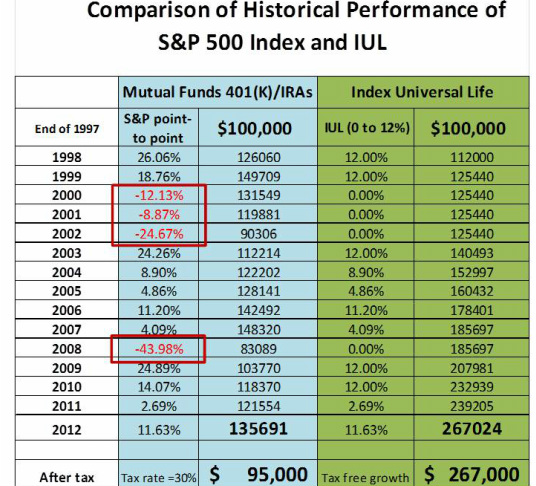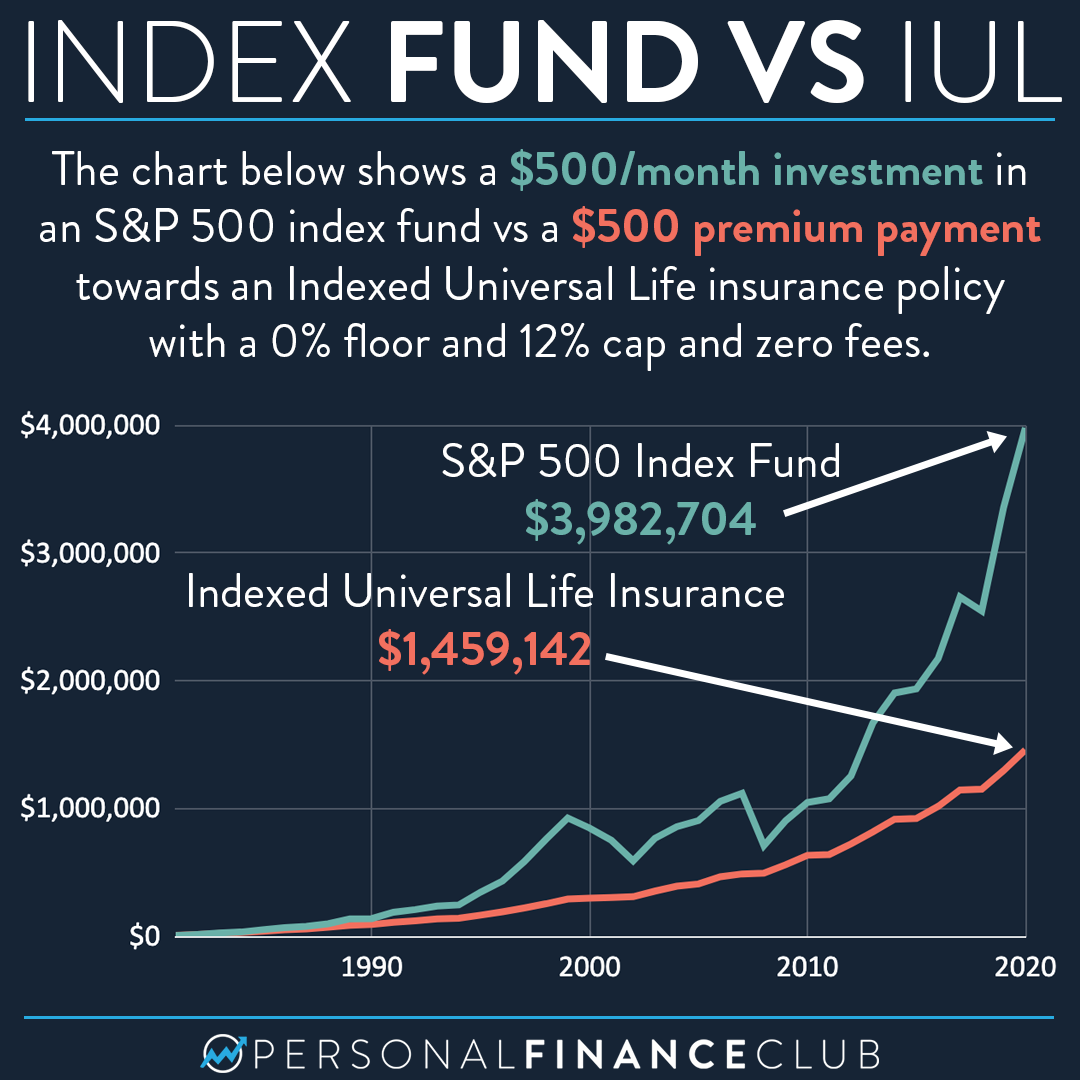All Categories
Featured
Table of Contents
Below is a theoretical contrast of historic performance of 401(K)/ S&P 500 and IUL. Let's assume Mr. SP and Mr. IUL both had $100,000 to saved at the end of 1997. Mr. SP spent his 401(K) cash in S&P 500 index funds, while Mr. IUL's money was the cash money worth in his IUL policy.
IUL's policy is 0 and the cap is 12%. Considering that his cash was conserved in a life insurance plan, he does not need to pay tax!
Minnesota Life Iul

The countless options can be mind boggling while researching your retirement investing alternatives. However, there are specific decisions that ought to not be either/or. Life insurance policy pays a survivor benefit to your beneficiaries if you must pass away while the plan holds. If your family members would encounter monetary difficulty in the event of your fatality, life insurance policy offers peace of mind.
It's not one of one of the most profitable life insurance policy financial investment strategies, yet it is one of the most secure. A kind of irreversible life insurance policy, global life insurance coverage enables you to select just how much of your premium goes towards your survivor benefit and just how much goes right into the policy to build up cash money value.

Additionally, IULs allow policyholders to get finances against their plan's cash money value without being tired as income, though overdue equilibriums may be subject to tax obligations and penalties. The primary advantage of an IUL policy is its possibility for tax-deferred growth. This implies that any revenues within the plan are not taxed up until they are withdrawn.
Alternatively, an IUL plan might not be one of the most appropriate financial savings prepare for some people, and a typical 401(k) could prove to be extra helpful. Indexed Universal Life Insurance Policy (IUL) plans offer tax-deferred development capacity, security from market slumps, and survivor benefit for beneficiaries. They allow insurance policy holders to make interest based upon the performance of a securities market index while protecting against losses.
National Life Iul
A 401(k) plan is a prominent retirement financial savings choice that enables individuals to spend money pre-tax into various financial investment tools such as mutual funds or ETFs. Employers might also supply matching payments, even more improving your retirement savings possibility. There are two primary types of 401(k)s: conventional and Roth. With a standard 401(k), you can decrease your taxed earnings for the year by contributing pre-tax bucks from your income, while also benefiting from tax-deferred growth and company matching contributions.
Many companies additionally provide matching contributions, efficiently giving you cost-free money in the direction of your retired life strategy. Roth 401(k)s function similarly to their standard counterparts but with one secret distinction: tax obligations on payments are paid upfront as opposed to upon withdrawal during retirement years (IUL vs 401(k): A Comprehensive Comparison). This means that if you expect to be in a higher tax obligation brace during retired life, contributing to a Roth account could minimize taxes gradually contrasted with spending solely via standard accounts (source)

With lower administration fees on average contrasted to IULs, these kinds of accounts allow investors to save cash over the long-term while still taking advantage of tax-deferred development possibility. Additionally, several prominent low-cost index funds are readily available within these account kinds. Taking distributions before getting to age 59 from either an IUL plan's money worth via loans or withdrawals from a standard 401(k) strategy can lead to damaging tax effects if not managed carefully: While obtaining against your plan's cash money value is generally thought about tax-free as much as the quantity paid in costs, any overdue finance equilibrium at the time of death or policy abandonment might be subject to earnings tax obligations and penalties.
Wrl Freedom Global Iul
A 401(k) provides pre-tax investments, employer matching payments, and possibly more investment options. The disadvantages of an IUL include higher administrative expenses compared to standard retirement accounts, constraints in investment options due to policy constraints, and prospective caps on returns during solid market performances.

While IUL insurance coverage may show useful to some, it is very important to understand just how it works prior to purchasing a policy. There are numerous advantages and disadvantages in comparison to various other types of life insurance policy. Indexed universal life (IUL) insurance plan provide better upside possible, versatility, and tax-free gains. This kind of life insurance coverage offers irreversible protection as long as costs are paid.
As the index relocates up or down, so does the rate of return on the cash money value part of your plan. The insurance firm that releases the plan may provide a minimum guaranteed price of return.

Economic experts frequently suggest living insurance coverage that amounts 10 to 15 times your annual income. There are numerous downsides connected with IUL insurance coverage that movie critics fast to explain. For example, somebody that establishes the plan over a time when the market is choking up could wind up with high costs repayments that do not contribute whatsoever to the cash money value.
Besides that, bear in mind the complying with other factors to consider: Insurance provider can set involvement rates for just how much of the index return you get each year. As an example, let's say the policy has a 70% participation rate (iul leads). If the index expands by 10%, your cash money worth return would certainly be only 7% (10% x 70%)
In addition, returns on equity indexes are often topped at a maximum amount. A plan may state your optimum return is 10% annually, regardless of just how well the index carries out. These restrictions can limit the real rate of return that's credited towards your account each year, no matter exactly how well the policy's underlying index performs.
John Hancock Protection Iul
It's essential to consider your individual danger tolerance and financial investment goals to ensure that either one lines up with your general strategy. Whole life insurance plans often include a guaranteed rate of interest with predictable premium amounts throughout the life of the plan. IUL policies, on the other hand, deal returns based upon an index and have variable costs with time.
There are lots of various other kinds of life insurance policy plans, discussed listed below. uses a set advantage if the insurance holder dies within a collection duration of time, typically in between 10 and 30 years. This is just one of the most budget-friendly kinds of life insurance, along with the most basic, though there's no money worth accumulation.
Indexed Life Insurance Vs Traditional 401k
The policy gains value according to a repaired timetable, and there are less costs than an IUL plan. A variable plan's cash value might depend on the efficiency of certain stocks or other securities, and your costs can also alter.
Latest Posts
Life Insurance Term Vs Universal
What Is The Difference Between Term And Universal Life Insurance
Indexed Universal Life Insurance Vs Term